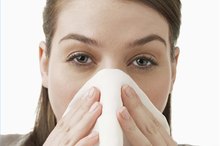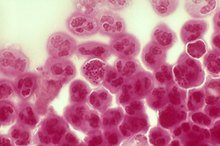What does fact checked mean?
At Healthfully, we strive to deliver objective content that is accurate and up-to-date. Our team periodically reviews articles in order to ensure content quality. The sources cited below consist of evidence from peer-reviewed journals, prominent medical organizations, academic associations, and government data.
- Center for Disease Control and Prevention: Trichomoniasis - CDC Fact Sheet
- Mayo Clinic: Genital Herpes
The information contained on this site is for informational purposes only, and should not be used as a substitute for the advice of a professional health care provider. Please check with the appropriate physician regarding health questions and concerns. Although we strive to deliver accurate and up-to-date information, no guarantee to that effect is made.
Vaginal Discomfort While Running
Vaginal discomfort while running can range in symptoms and severity of itching, burning, swelling and pain. There are several causes for vaginal discomfort that may or may not be sexually related. Always seek medical attention if you experience vaginal discomfort, especially if you’re sexually active.
If you are experiencing serious medical symptoms, seek emergency treatment immediately.
Common Causes
Bacterial vaginosis, or BV for short, is the most common cause of vaginal discomfort resulting from an overgrowth of certain types of bacteria that are normally found in the vagina. Having multiple sex partners increases your risk of BV, but it is not a sexually-transmitted disease. The exact cause is unknown. BV causes burning, itching, pain and odor in the vaginal region.
A yeast infection is the second most common cause of vaginal discomfort and this is usually caused by the fungi Candida albicans. Symptoms include itching and burning inside the vagina and the vulva region. Discharge with the consistency of cottage cheese is another common symptom of yeast infections.
- Bacterial vaginosis, or BV for short, is the most common cause of vaginal discomfort resulting from an overgrowth of certain types of bacteria that are normally found in the vagina.
Sexually Transmitted Causes
What Are the Symptoms of Trichomoniasis & Bacterial Vaginosis?
Learn More
Trichomoniasis or herpes simplex virus can cause vaginal discomfort while running. Trichomoniasis is caused by the protozoan parasite, Trichomonas vaginalis. This sexually-transmitted disease, or STD, can be caused from penis-to-vagina contact or vulva-to-vulva contact, according to the Center for Disease Control and Prevention 1. Irritation and itching of the genitals occur within a week to a month of exposure to an infected person. A pelvic exam showing small red sores on the vaginal wall or cervix indicates trichomoniasis. Both partners will be treated with metronidazole or tinidazole. Herpes simplex virus can be very painful while running because of blisters around the vagina and possibly the inner thigh. The blisters typically develop within a couple weeks after contact with an infected partner and there will be pain and itching in the vaginal area. You may also have flu-like symptoms, according to Mayo Clinic. There is no cure for genital herpes, but anti-viral medications can help your blisters heal sooner and make them less severe 2.
Non-Sexual Causes
A urinary tract infection, or UTI, can also cause vaginal discomfort while running. A UTI occurs when bacteria enters the urinary tract through the urethra. You may experience pelvic pain and a strong urge to urinate while running, but when you finally get to a bathroom, only a small amount of urine comes out accompanied by a moderate-to-severe burning sensation. The urine may also smell or be cloudy. This is more common for female runners than males because females have a shorter urethra, so bacteria doesn’t have far to travel. Antibiotics can treat most urinary tract infections. Wipe front-to-back to avoid the spread of bacteria from your anus to your vagina to avoid this type of infection. Vaginal irritation can also be caused by using tampons, pads and deodorized soaps.
- A urinary tract infection, or UTI, can also cause vaginal discomfort while running.
Considerations
Swimming & Yeast Infections
Learn More
Never assume you know the cause of your vaginal discomfort while running. Always seek medical attention because infections left untreated increases your risk of pelvic inflammatory disease, infertility, and sexually-transmitted diseases. Always keep your vagina clean and dry. Change your sweaty running clothes as soon as you get home and avoid wearing tight clothing that locks in moisture. If you are prescribed antibiotics, finish the entire prescription even if your symptoms disappear sooner.
- Never assume you know the cause of your vaginal discomfort while running.
- If you are prescribed antibiotics, finish the entire prescription even if your symptoms disappear sooner.
Related Articles
References
- Center for Disease Control and Prevention: Trichomoniasis - CDC Fact Sheet
- Mayo Clinic: Genital Herpes
- Illinois Department of Public Health: Vaginitis
- American Academy of Allergy Asthma and Immunology. (2013). Vaginal Pain With Intercourse: Seminal Fluid Allergy?
- Hamilton RG. (2016). Latex Allergy: Epidemiology, Clinical Manifestations, and Diagnosis. In: UptoDate, Bochner BS, (Ed), UpToDate, Waltham, MA.
- Sobel JD. (2016). Approach to Women With Symptoms of Vaginitis. In: UpToDate, Barbieri RL, (Ed), UpToDate, Waltham, MA.
- Sobel JD. (2016). Patient Education: Vaginal Discharge in Adult Women (Beyond the Basics). In: UptoDate, Barbieri RL, (Ed), UptoDate, Waltham, MA.
- Martin lopez JE. Candidiasis (vulvovaginal). BMJ Clin Evid. 2015;2015
- Javed A, Parvaiz F, Manzoor S. Bacterial vaginosis: An insight into the prevalence, alternative treatments regimen and it's associated resistance patterns. Microb Pathog. 2019;127:21-30. doi:10.1016/j.micpath.2018.11.046
- Bernstein JA. Human seminal plasma hypersensitivity: an under-recognized women's health issue. Postgrad Med. 2011;123(1):120-5. doi:10.3810/pgm.2011.01.2253
- Fistarol SK, Itin PH. Diagnosis and treatment of lichen sclerosus: an update. Am J Clin Dermatol. 2013;14(1):27-47. doi:10.1007/s40257-012-0006-4
- American Academy of Allergy Asthma and Immunology. (2013). Vaginal Pain With Intercourse: Seminal Fluid Allergy?
- Hamilton RG. (2016). Latex Allergy: Epidemiology, Clinical Manifestations, and Diagnosis. In: UptoDate, Bochner BS, (Ed), UpToDate, Waltham, MA.
- Pappas PG et al. Clinical Practice Guideline for the Management of Candidiasis: 2016 Update by the Infectious Diseases Society of America. Clin Infect Dis. 2016; 62:e1.
- Sobel JD. (2016). Approach to Women With Symptoms of Vaginitis. In: UpToDate, Barbieri RL, (Ed), UpToDate, Waltham, MA.
- Sobel JD. (2016). Patient Education: Vaginal Discharge in Adult Women (Beyond the Basics). In: UptoDate, Barbieri RL, (Ed), UptoDate, Waltham, MA.
Writer Bio
Melissa McNamara is a certified personal trainer who holds a Bachelor of Arts in journalism and communication studies from the University of Iowa. She writes for various health and fitness publications while working toward a Bachelor of Science in nursing.









